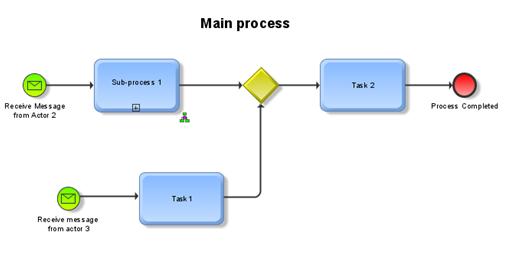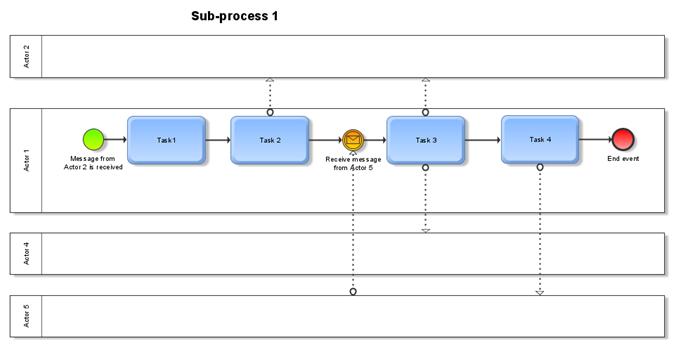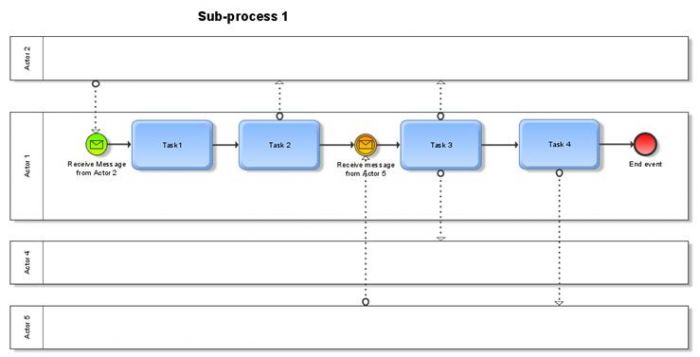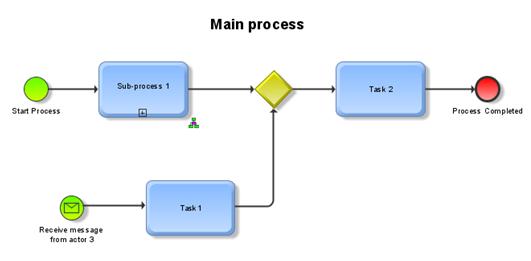
Hello Community,
I would like to ask your help to find out solution on modelling proper process start triggers.
Backgroud information: Approach in modelling is that main (overview) model contains main process steps and interaction with other actors and detailed information is in sub-processes (for each sub-process there might be different actors involved).
Example of issue:
Main process start can be triggered by one or other message received from different actors.
1st modelling variant:
So then when we navigate to sub-process 1 (as a separate process), we lose important information as receive of message is left on main process.
2nd variant: to model is that receive of message is modelled in sub-process, which then gives complete information of information exchange.
But then problem that one flow of main process does not have proper start trigger anymore (receive of message).
Or 3rd variant: modelling start receive messages in both, main process and sub-process, but that is not anymore BPMN compliant, I guess ...
What could be other BPMN and/or ARIS solutions to handle this issue with process start triggers in a proper way? To have full information on message exchange in sub-process and at the same time to have proper process start trigger in main (overview) process.
Different modelling style? Or other way to use BPMN notation?
Thank you a lot for any help and advices on this!:)
Ilze,
BPMN does not allow pools or lanes in a Sub-process. And I don't think you can start a Sub-process with a Message Receive Event either. A sub-process is always started by its parent event (untyped start event). It is arguable if it could have another start event. But even those who think it can at least admit that could only be a signal, timer and suchlike but not Message Receive Event. If you can start a sub-process by a Message Receive Event that would mean that you can model an incoming message flow from a partner of the parent. When you assign a process, ARIS allows you to do things that are not compliant but if you try it with embedded sub-process you'll see that you can't and that's a correct method restriction. So it is good to test the content of a sub-process when embedded to be sure about BPMN compliance.
This was only about what is not allowed and nothing about why because it could make the comment quite long to go into this.
In conclusion, the variant 1 - but without pools - seems like the only option.
But I would be interested to hear more opinions on that.
Hi Ivo,
Many thanks for your input.
For such modelling style reason is that sub-process is re-usable, would solution then be to use called process? as from BPMN v2.0, but I am not yet quite familiar with this object.
From notation I understand that called process is an independet process, so I assume it can contain lanes and pools and also then interaction between pools, would it be correct assumption?
Therefore can then called process contain also message start event (to trigger to start process when it is executed on its own) and then probably also untyped start event (when it is called from other process where trigger is already modelled)?
Just tried in ARIS. I see that it is possible to use Call Activity object and link it with BPMN process diagram, but it is not possible to link it with BPMN collaboration diagram, then does it still means that Call Activity can contain only process for one actor?
If so then it seems that modelling restrictions in ARIS are the same for called activity as for sub-process, but purposes for those both from notation are quite different as I read, so I get confused with this.....
Many thanks again for any clarifications on this.
BR,
Ilze
Yes, Ilze, calling a global process can solve part of the problem. As the global process is independent, it can have lanes and can exchange messages with other processes.
You can model the received message content identifier as a data Input object in the global process associated with the pertinent tasks there (in most cases probably with the frist task) . Although it can't be visible in the global process that it's triggered by a particular receive massage events in one of the calling processes, at least the name of the data input object can convey some information about that.
You can link a call activity only to a global process, not collaboration. That's why this method restriction is correct. How to show the participation of global processes in collaboration seems a challenge in the current realisation of BPMN2 in ARIS. Some tweaking using occurrences can work only in combination with locking mechanism or another way of ensuring consistency. There should be only one place to change a global process and this changes should appear in all 'occurrences' of the process. The occurrence concept in ARIS works only with objects and connections, not with models or parts of them for example - content of a pool. Such situations are one of the many reasons, I'm looking forward to seeing simulation available for BPMN2 models. It would be nice when trying to find a solutions to similar problem, to be able to test them.
If some idea for solution pops up, I'll share it in this thread..


















